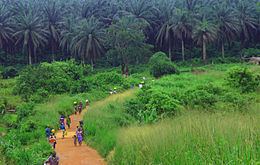 | ||
The Guinean forest-savanna mosaic is an ecoregion of West Africa, a band of interlaced forest, savanna, and grassland running east to west and dividing the tropical moist forests near the coast from the West Sudanian savanna of the interior.
Contents
Setting
The Guinean forest-savanna mosaic covers an area of 673,600 square kilometers (260,100 sq mi), extending from western Senegal to eastern Nigeria, and including portions of Gambia, Guinea Bissau, Guinea, Sierra Leone, Côte d'Ivoire, Ghana, Togo, and Benin. The Cameroon Highlands of eastern Nigeria and Cameroon separate the Guinean forest-savanna mosaic from the Northern Congolian forest-savanna mosaic, which lies to the east. The Dahomey Gap is a region of Togo and Benin where the forest-savanna mosaic extends to the coast, and separates the Upper Guinean forests of Guinea, Sierra Leone, Liberia, Côte d'Ivoire, and Ghana from the Lower Guinean forests of Nigeria and Cameroon.
Flora
This region is mainly grassland crossed with trees growing alongside streams and on hillsides, with the constantly occurring fires keeping back the growth of trees in open country. Lophira laceolata is a tree that is more resistant to fire.
Fauna
The mixture of forest and grassland provide habitat for a range of species from large mammals such as African leopard, forest elephants, hippopotamus and antelopes such as the red-flanked duiker to the common tortoise as well as more localised species including patas monkeys and Ghana worm lizards (Amphisbaenia).
The wetlands in the region are rich in birdlife, including iris glossy-starling and black crowned crane.
Human settlement
The ecoregion covers large areas of many West African nations including:
Threats and preservation
This area has been populated by humans for millennia and very little of it is formally protected. Parks include Outamba-Kilimi National Park in Sierra Leone.
